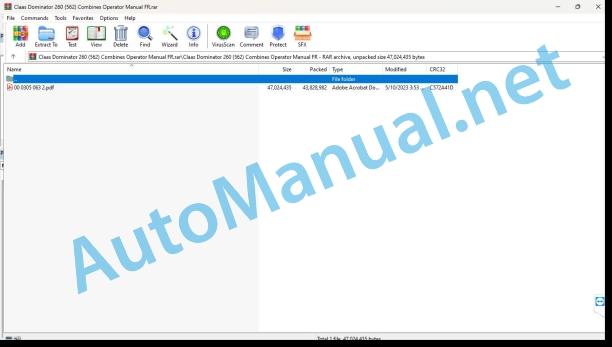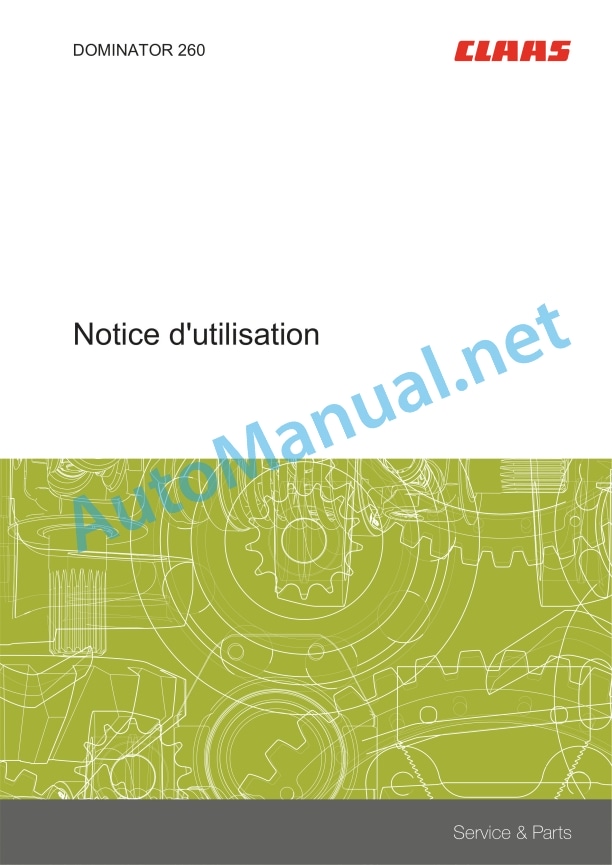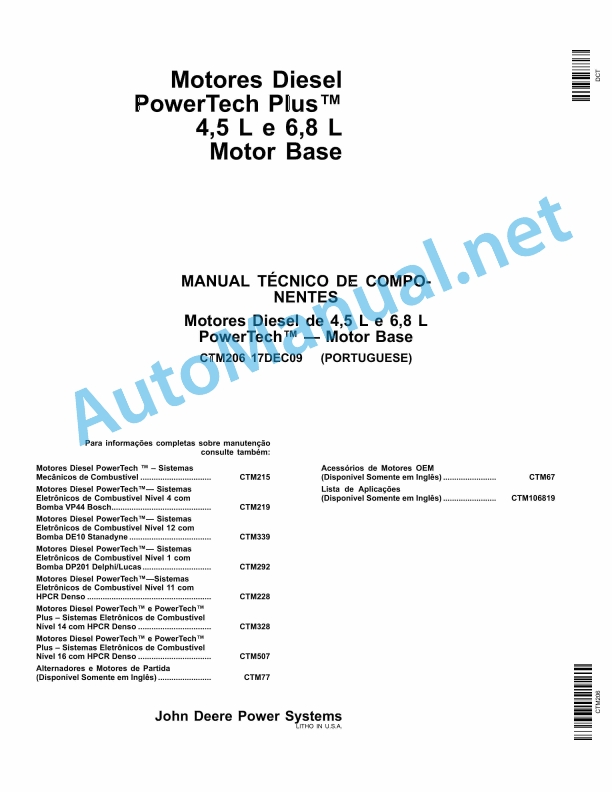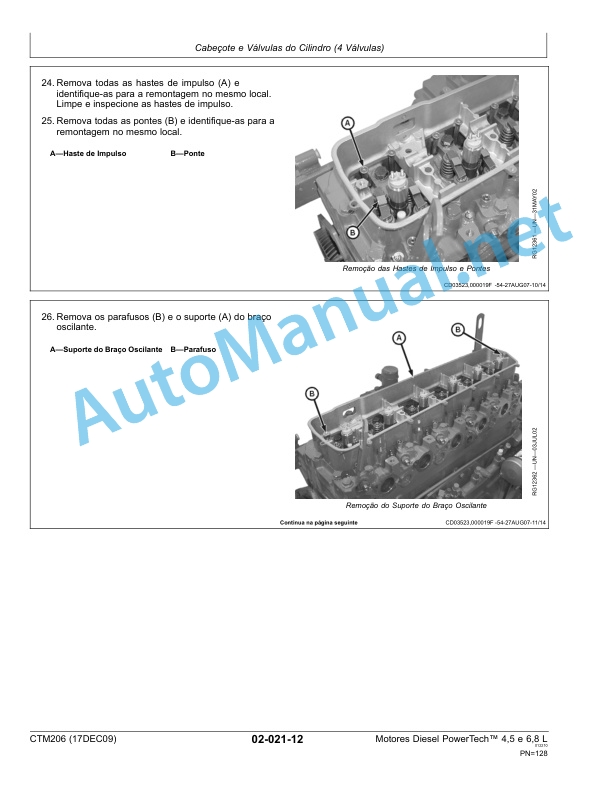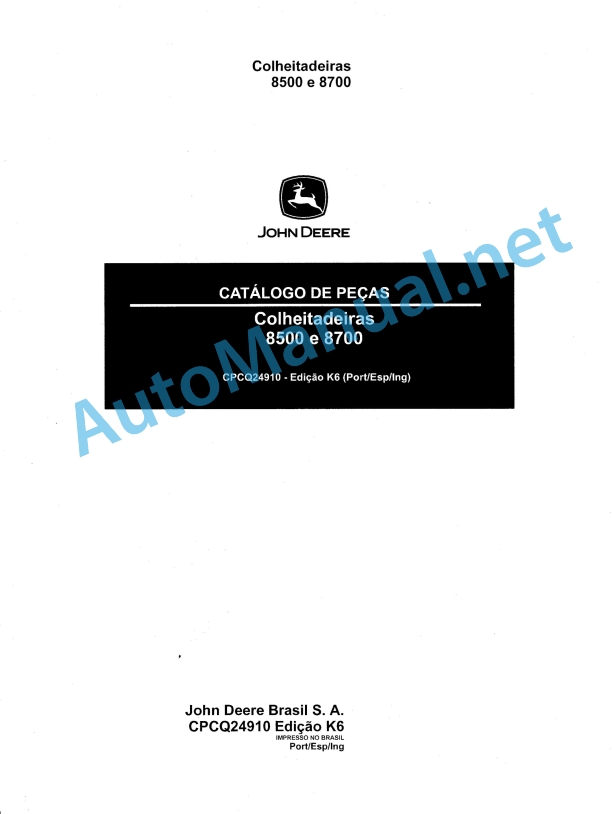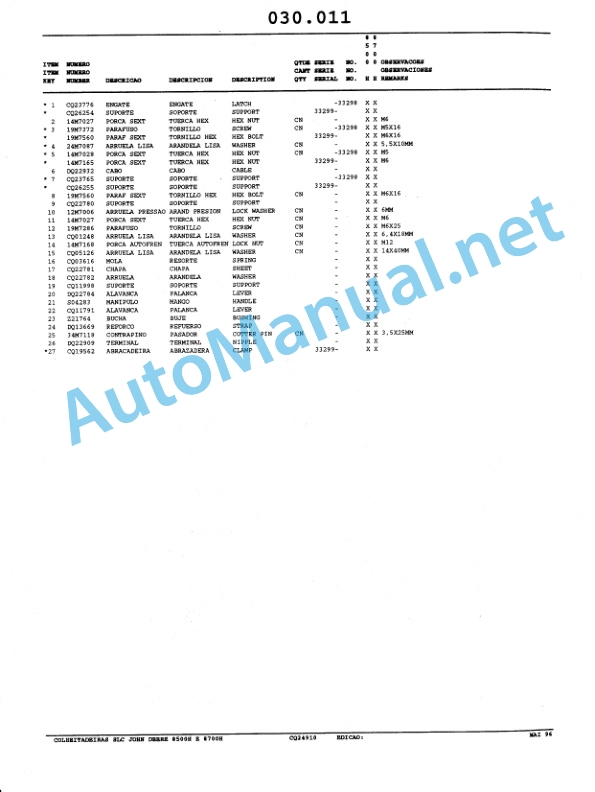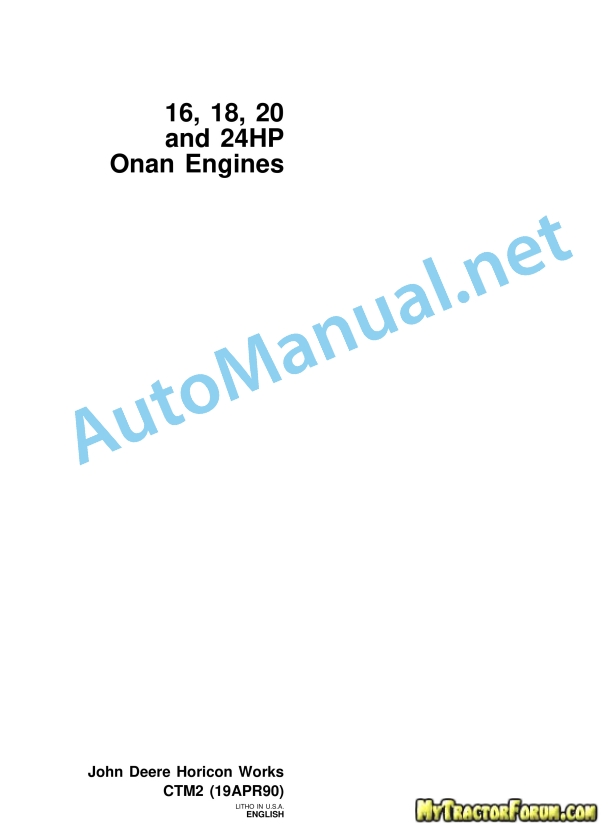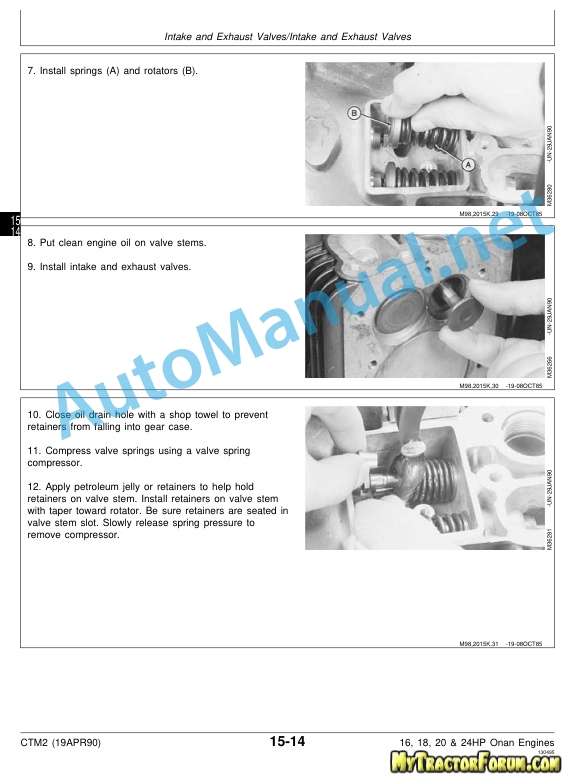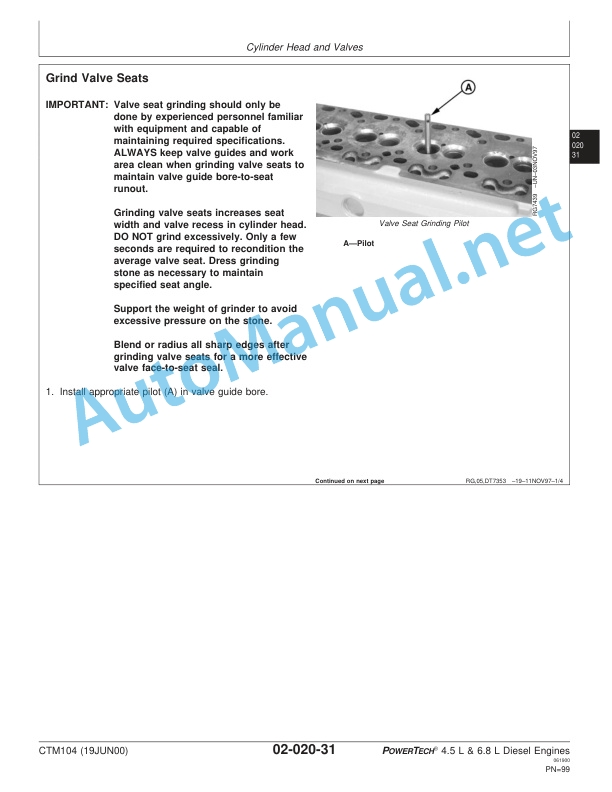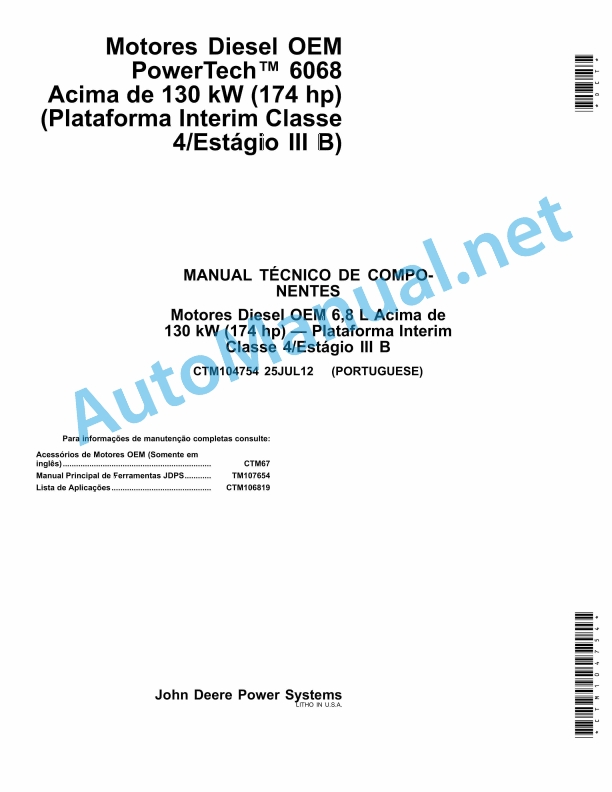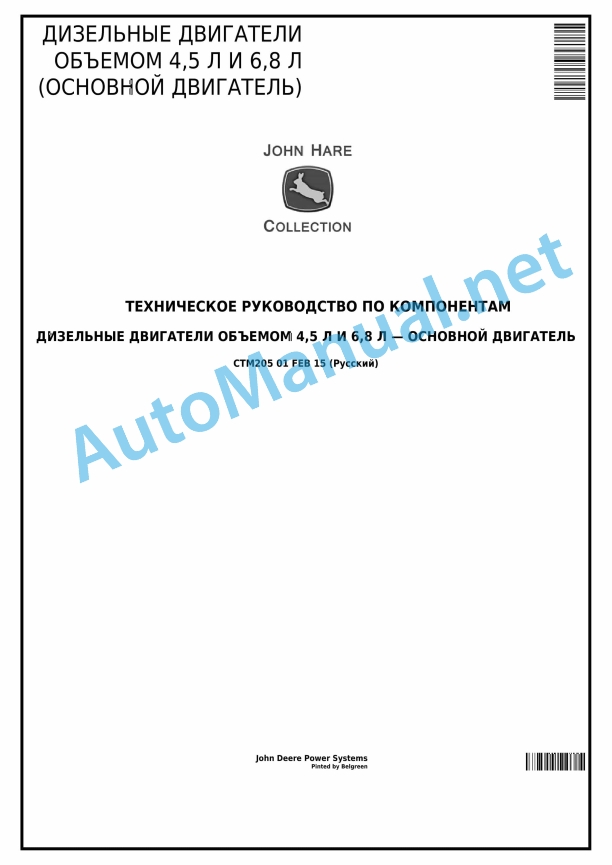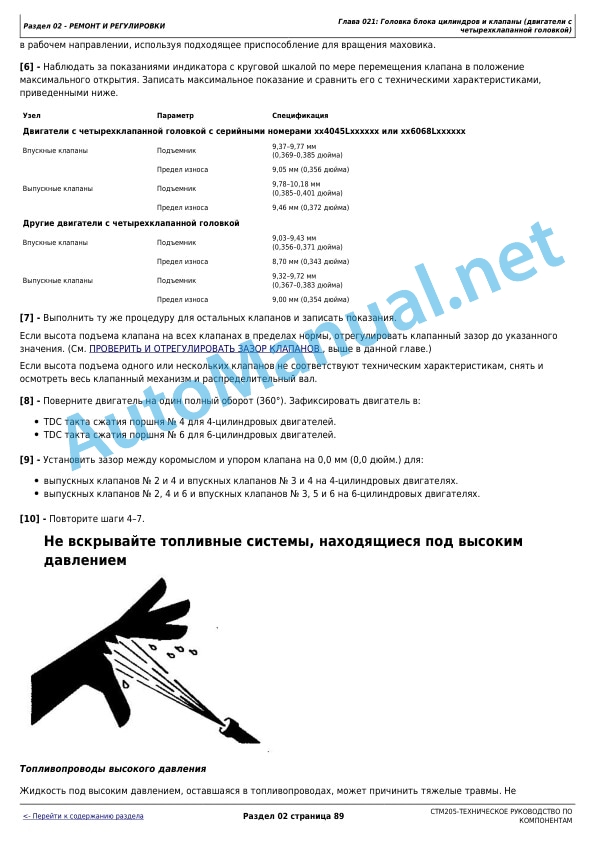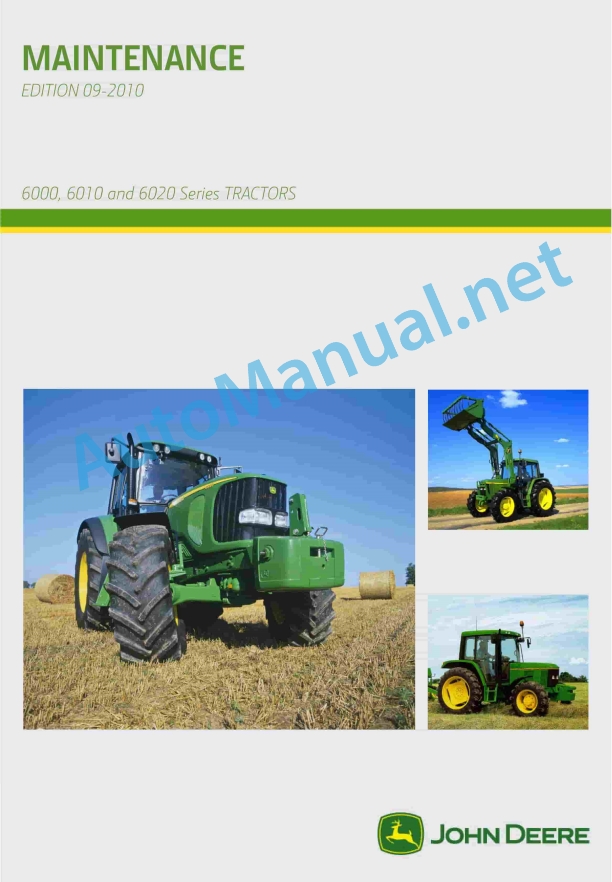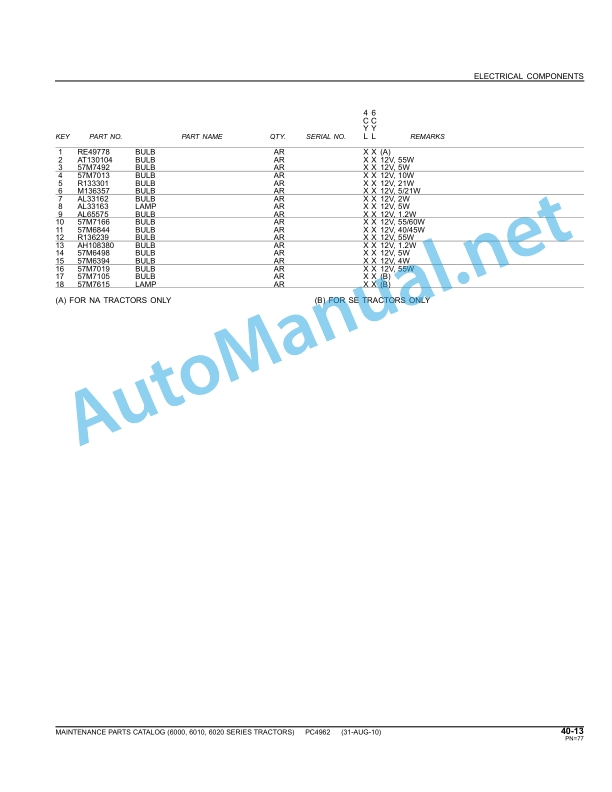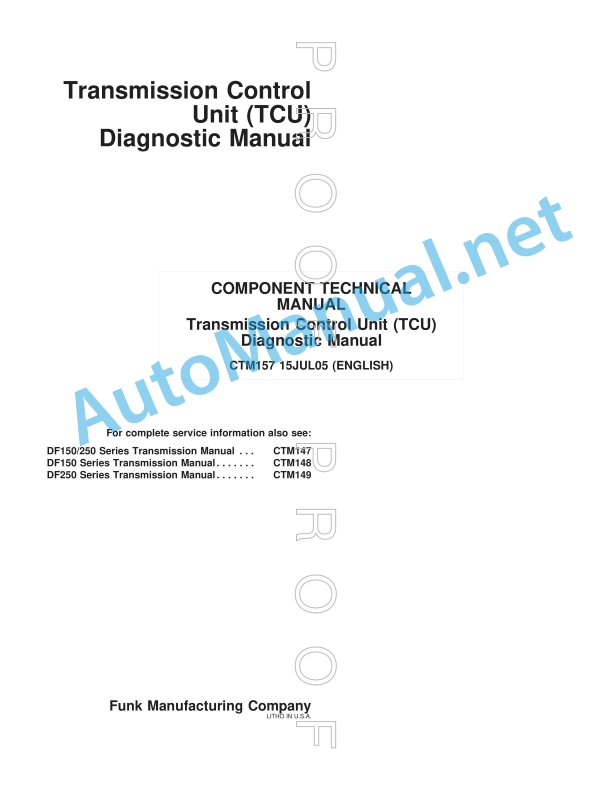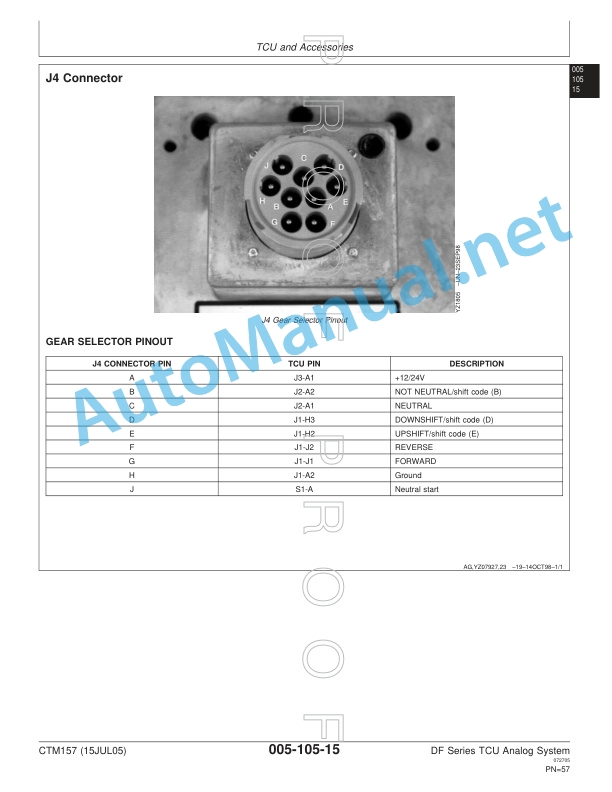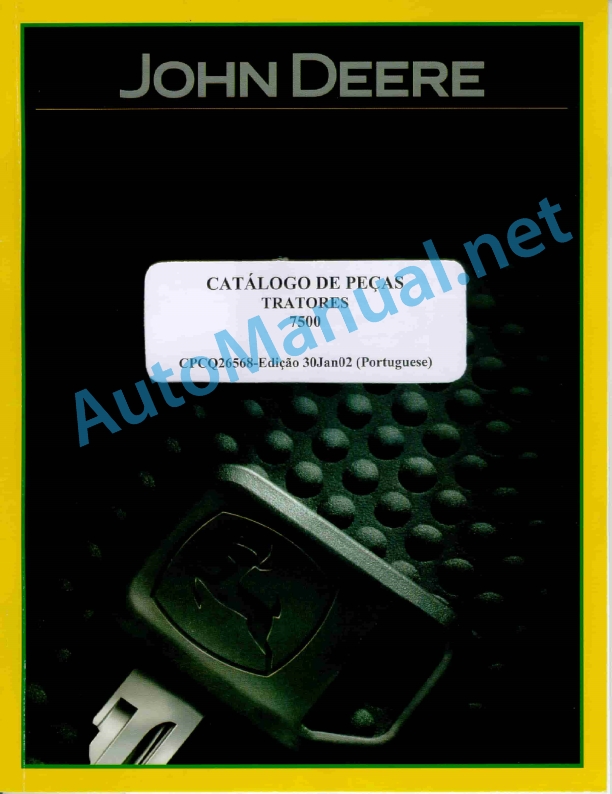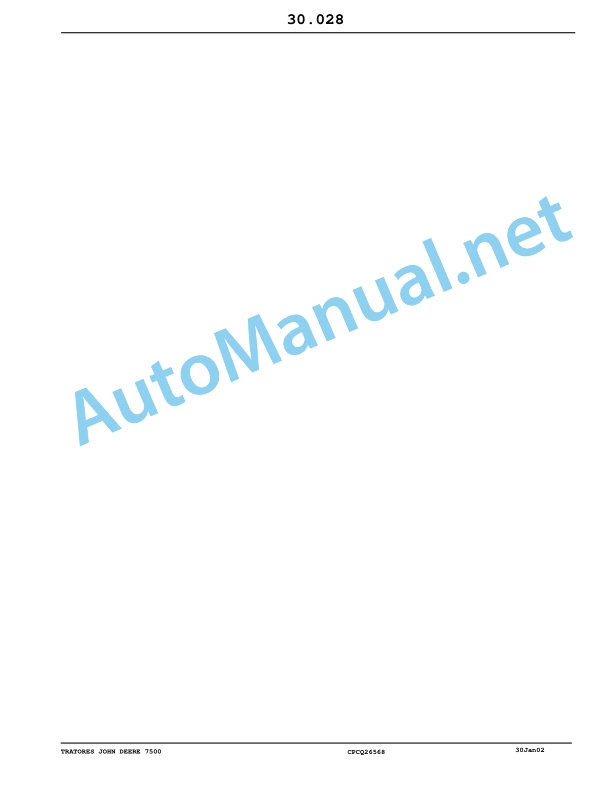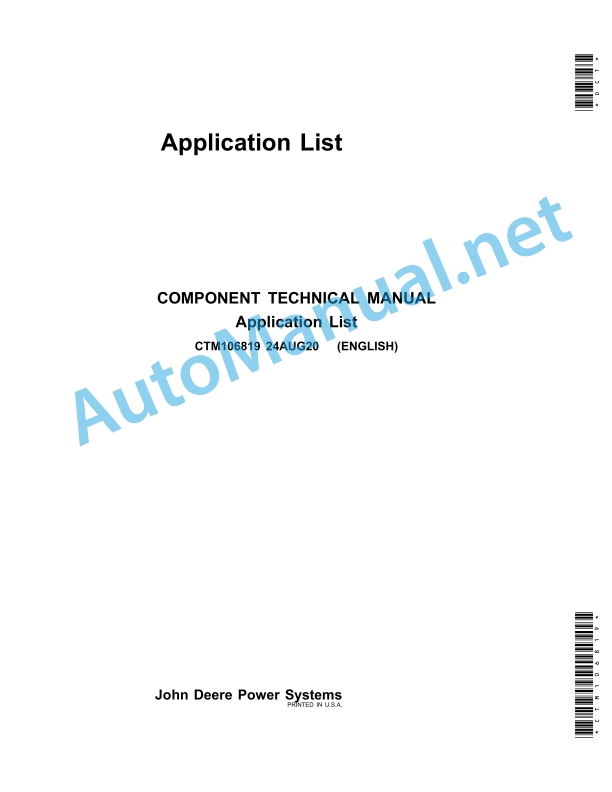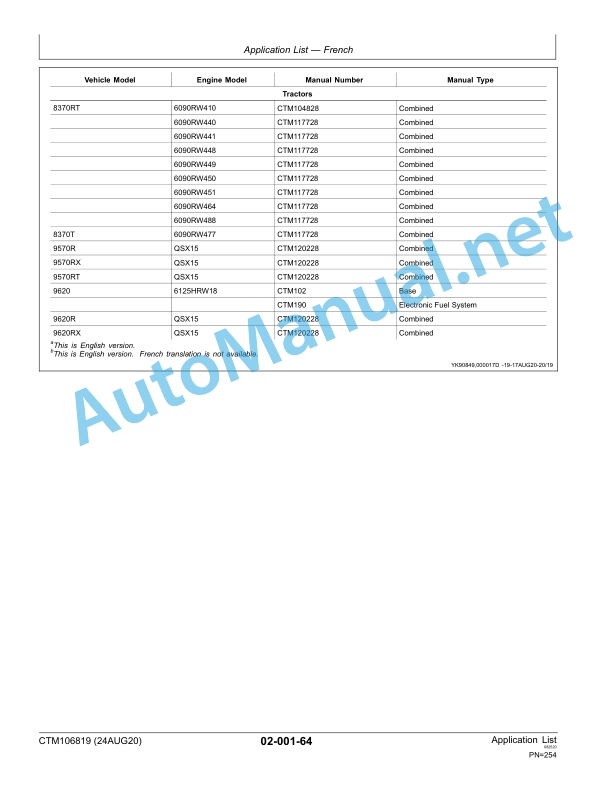Claas Dominator 260 (562) Combines Operator Manual FR
$50.00
- Model: Dominator 260 (562) Combines
- Type Of Manual: Operator Manual
- Language: FR
- Format: PDF(s)
- Size: 41.8 MB
File List:
00 0305 063 2.pdf
00 0305 063 2.pdf:
DOMINATOR 260
Contents
1 Introduction
1.1 Notes regarding the instructions
1.1.1 Validity of the notice
1.1.2 Information regarding this user manual
1.1.3 Icons and notes
1.1.4 Optional equipment
1.1.5 Qualified specialist workshop
1.1.6 Notes on maintenance
1.1.7 Notes regarding warranty
1.1.8 Spare parts and technical questions
1.2 Use in accordance with instructions
1.2.1 Use in accordance with the provisions
1.2.2 Reasonably foreseeable misuse
2 Security
2.1 Recognize the warnings
2.1.1 Warning pictogram
2.1.2 Signal word
2.2 Safety tips
2.2.1 Meaning of the instructions for use
2.2.2 Observe warning pictograms and warnings
2.2.3 Requirements for all people who work with the machine
2.2.4 Children at risk
2.2.5 Dangerous areas
2.2.6 Do not stand between the machine and the front tool
2.2.7 Guide passenger during work
2.2.8 Couple the machine with the front tool or cutting carriage
2.2.9 Risk of injury due to rotating shafts
2.2.10 Constructive modifications
2.2.11 Optional equipment and spare parts
2.2.12 Checking the running machine
2.2.13 Operation only after proper commissioning
2.2.14 Technical condition
2.2.15 Risks in the event of damage to the machine
2.2.16 Respect the technical threshold values
2.2.17 Danger due to inertia of machine elements
2.2.18 Maintain safety devices in operational capacity
2.2.19 Personal protective equipment
2.2.20 Wear suitable clothing
2.2.21 Remove dirt and loose objects
2.2.22 Risks when traveling on the road and in the fields
2.2.23 Park the machine correctly
2.2.24 Inappropriate operating consumables
2.2.25 Safety in handling operating consumables and secondary consumable materials
2.2.26 Fuel is harmful to health
2.2.27 Refrigerants are harmful to health
2.2.28 Environmental protection and disposal
2.2.29 Avoiding fires
2.2.30 Fatal electric shock from overhead power lines
2.2.31 Behavior in the event of voltage discharge from overhead power lines and lightning strikes
2.2.32 Electric shock from the electrical system
2.2.33 Noise can cause health problems
2.2.34 Vibrations can be harmful to health
2.2.35 Liquids under pressure
2.2.36 Compressed air
2.2.37 Toxic exhaust gases
2.2.38 Hot surfaces
2.2.39 Safety when getting on and off
2.2.40 Work only on the stopped machine
2.2.41 Maintenance and repair work
2.2.42 Machine elements recorded and loads
2.2.43 Risks due to welding work
2.2.44 Checking and charging the battery
2.3 Safety label
2.3.1 Structure of warning pictograms
2.3.2 Diesel engine warning pictogram
2.3.3 Hydraulic system warning pictograms
2.3.4 Cabin warning pictogram
2.3.5 Power group warning pictograms
2.3.6 Threshing gear warning pictogram
2.3.7 Cleaning warning pictogram
2.3.8 Warning pictogram for depositing harvested product and depositing straw
2.3.9 Grain recovery warning pictogram
2.3.10 Warning pictogram for assembled parts and machine casing
3 Description of the machine
3.1 Overview and mode of operation
3.1.1 Overview of the machine from the front and left side
3.1.2 Overview of the machine from the rear and right side
3.1.3 Operating mode of the machine
3.1.4 Overview of Perkins 1106D-E70TA diesel engine
3.1.5 Overview of concaves
3.1.6 Closing system
Standard closing system
3.2 Optional equipment
3.2.1 4-TRAC*
3.3 Nameplates and identification numbers
3.3.1 Nameplate on the Perkins 1106D-E70TA diesel engine
3.3.2 Machine nameplate
3.3.3 Rating plate, drive axle
3.3.4 Nameplate, steering axle
3.3.5 Straw chopper nameplate
3.4 Machine information
3.4.1 Undercarriage sticker
3.4.2 Grain recovery sticker
3.4.3 Stickers on assembled parts and machine casing
3.4.4 Hydraulic system sticker
4 Control and display elements
4.1 Cabin and driving position
4.1.1 Driving position
4.1.2 Control console
4.1.3 Cabin roof
4.1.4 Road lighting and working lights
4.1.5 Driver’s seat
4.1.6 Steering column
4.1.7 Column B
4.1.8 Ignition lock
4.1.9 Multifunction handle
4.1.10 Air conditioning
4.1.11 Camera systems screen*
4.1.12 Windshield washer fluid reservoir
4.2 On-board computer and display screen/indicators
4.2.1 CEBIS general advice
4.2.2 Overview of the driving indicator
4.2.3 Overview of the harvest indicator
4.2.4 Menu
4.2.5 Take messages on CEBIS into account
Consider the category of messages
Respect the structure of error code information
Disable error code information
View alarm history
View active alarms
4.2.6 Message box symbols
5 Technical characteristics
5.1 DOMINATOR 260
5.1.1 Perkins 1106 D-E70TA
5.1.2 Sound pressure level and vibrations
5.1.3 Machine dimensions
5.1.4 Dimensionsfhe hopper discharge tube in working position
5.1.5 Turning circle diameter
Measurement conditions
5.1.6 Undercarriage
5.1.7 Drive axle track width
Tire pressure
5.1.8 Steering axle track width
Tire pressure
5.1.9 Brakes
5.1.10 Perkins 1106 D-E70TA diesel engine battery
5.1.11 Beater width
5.1.12 Threshing system
5.1.13 Separation
5.1.14 Cleaning
5.1.15 Deposit of harvested product and deposit of straw
5.1.16 Hopper volume
5.1.17 Hopper emptying power
5.1.18 Weight
5.2 Operating consumables
5.2.1 Lubricants
5.2.2 Coolant
5.2.3 Hydraulic oil
6 Preparing the machine
6.1 Stop and immobilize the machine
6.1.1 Stop and immobilize the machine
6.1.2 Block the machine to avoid any risk of movement
6.2 Access workstations and maintenance stations
6.2.1 Pivoting the front ladder up and down
Swivel the front ladder upwards to the transport position
Pivot the front ladder down to the access position
6.2.2 Using the rear ladder
Bring the rear ladder to transport position
Bring the rear ladder to the up position
Remove and install the rear ladder
6.2.3 Enter the workstation
Enter the workstation
6.2.4 Access maintenance stations
Enter the maintenance station
Enter the maintenance station
Access the maintenance station
Access the maintenance station
6.2.5 Entering access areas
Enter the
Enter the access area
Access the
Enter the access area of the
Enter the access area
6.3 Prepare the machine for moving
6.3.1 Prepare for road travel
6.3.2 Prepare for movement in the field
6.4 Adjusting the machine for work
6.4.1 Set the machine to harvest grain
6.4.2 Set the machine arvcorn
6.4.3 Set the machine to harvest rice
6.4.4 Set the machine from rice harvest to grain harvest
6.4.5 Threshing table
6.4.6 Using a machine with rice equipment
6.4.7 Grid table
6.4.8 Threshing segment
6.4.9 Clean the machine for harvesting the seed
6.5 Load the machine
6.5.1 Loading and securing the machine
6.5.2 Remove the lifting eyes
6.6 Front tool
6.6.1 Installing and removing the front tool
6.6.2 Prepare for locking
6.6.3 Install the locking pawl
6.6.4 Check the front implement discharge pressure accumulator
6.7 Diesel engine
6.7.1 Select the permitted fuel
6.7.2 Comply with the fuel specification
6.7.3 Respect the fuel specification
6.7.4 Select the permitted fuel
6.7.5 At low temperatures use winter fuel
6.7.6 Refueling the machine
6.8 Chassis
6.8.1 Dismantling and installing the wheels
Remove the wheels
Install the wheels
6.8.2 Place the machine on jack stands
6.8.3 Place the machine on jack stands
6.8.4 Raise the machine for swing of the steering axle
6.8.5 Adapting the steering axle from transport position to working position
6.8.6 Adjusting the track width of the steering axle
Take out the adjustment element
6.9 Brake
6.9.1 Check the parking brake
6.9.2 Check the service brake
6.10 Coupling device
6.10.1 Install the hitch yoke
6.10.2 Hitching the trailer
6.10.3 Unhitching the trailer
6.11 Hydraulics
6.11.1 Identify hydraulic oil
6.12 Electrical and electronic system
6.12.1 Install the air conditioning compressor fuse
6.12.2 Adjusting the dipped headlights
6.12.3 Switching road lighting depending on the front implement
6.13 Cabin and driving position
6.13.1 Install the proximity mirror*
6.13.2 Adjust the proximity mirror*
6.13.3 Check visibility zones
6.13.4 Remove the transport safety device from the cabin
6.13.5 Adjusting the drive lever control resistance
6.14 Power group
6.14.1 Adjust the return pulley in the feed channel
6.14.2 Install the safety support at the level of the supply channel
6.14.3 Take out the safety support at the supply channel
6.14.4 Check the anti-slip strips of the supply channel
6.15 Threshing bodies
6.15.1 Opening and closing the destoner container
6.15.2 Remove and install the destoner tray
Remove the destoner tray
Place the destoner tray
6.15.3 Opening and closing the mixer hatch
6.15.4 Remove and install the piling segment
6.15.5 Check concave adjustment
Gap of the concave at the level of the perforated concave N7/18* for wheat
Concave Gap at Rice Tooth Concave
Concave Gap at Round Bar Concave for Corn
6.15.6 Install and remove the beater cover
6.16 Separation
6.16.1 Remove and install the anti-splash fabric
Remove the anti-splash fabric
Install the anti-splash fabric
6.16.2 Remove and install the side separators
6.16.3 Remove and install the central separators
6.16.4 Remove and install the rear central separators
6.16.5 Remove and install the rice separators
6.16.6 Install and remove the CCM separators
6.17 Cleaning
6.17.1 Remove the grids
6.17.2 Install the grids
6.17.3 Check the basic setting of the grids
6.17.4 Cover and open the egg return*
6.18 Deposit of harvested product and deposit of straw
6.18.1 Adjust the speed of the straw chopper
6.18.2 Remove the counter-knives
6.18.3 Adjust the scattering plates of the deflector plate spreader
6.18.4 Place the rubber canvas* for corn on the straw chopper
6.19 Grain recovery
6.19.1 Close the discharge opening on the hopper
6.20 Assembly parts and bodywork
6.20.1 Checking the reverse horn
7.1 Driving the machine
7.1.1 Respect road traffic instructions
7.1.2 Operating the machine
Move the machine forward
Brake the machine
Stop the machine
Move in reverse
7.1.3 Switching the road travel switch
Switch the road travel switch to
Switch the road travel switch to
7.1.4 Maneuver the machine
7.1.5 Park the machine
7.2 Front tool
7.2.1 Connect the front tool to the control console
7.2.2 Disconnect the front tool on the control panel
7.2.3 Disconnect the front tool at the multifunction handle
7.2.4 Reverse the front tool
7.2.5 Adjust the reel speed
7.3 Diesel engine
7.3.1 Connect the diesel engine
Connect the diesel engine
Allow the diesel engine and hydraulic system to warm up if outside temperatures are between 0°C and -10°C.
Allow the diesel engine and hydraulic system to warm up if outside temperatures are between -10°C and -35°C.
7.3.2 Stopping the diesel engine
7.3.3 Adjusting the diesel engine speed
7.3.4 Notes on electronic engine management
7.4 Chassis
7.4.1 Submit a report
7.4.2 Connect 4-TRAC*
7.4.3 Disconnect 4-TRAC*
7.4.4 Driving characteristics
7.4.5 Tow the machine out of the risk area
.5.1 Brake the machine with the service brake pedal
7.5.2 Apply the parking brake
7.5.3 Release the parking brake
7.6 Management
7.6.1 Taking steering behavior into account
7.7 Electrical and electronic system
7.7.1 Learning machine speeds
7.7.2 Adjust slip thresholds
7.8 Cabin and driving position
7.8.1 Adjusting the steering column
7.8.2 Put on the seat belt
7.8.3 Connect the air conditioning and adjust it
7.8.4 Adjust the air conditioning air flow
7.8.5 Emergency exit
7.9 Ground guidance
7.9.1 Record nominal values for cutting height / ground pressure
7.10 Threshing bodies
7.10.1 Connect the beaters
7.10.2 Disconnect the threshing elements
7.10.3 Adjust the mixer speed
7.10.4 Adjusting the mixer speed range
7.11 Cleaning
7.11.1 Manually adjust the grids
7.11.2 Adjust the fan speed
7.12 Deposit of harvested product and deposit of straw
7.12.1 Adjusting the straw chopping length
7.12.2 Adjust the counteife
7.1Remove the counter-knives
7.12.4 Adjust the position of the deflector plate spreader
Adjust position
Adjust the straw guide plate
7.13 Grain recovery
7.13.1 Open the hopper cover
7.13.2 Adjust the cover plates of the hopper emptying auger
7.13.3 Check the return of the oats
7.13.4 Pivot the hopper discharge tube outwards and inwards
7.13.5 Connecting and disconnecting the hopper drain
8 Faults and solutions
8.1 CEBIS display
8.1.1 Editing an active error code
8.1.2 View alarm history
Show all alarms
Show information
Meaning of icons and abbreviations
8.2 Diesel engine
8.2.1 Diesel engine failures
8.2.2 Stopping the overheating diesel engine
8.2.3 Fuel, drain
8.2.4 Overview of diesel engine failures
8.3 Hydraulic system
8.3.1 Lower the front tool manually
8.4 Electrical and electronic system
8.4.1 Opening and closing the basic central electrical system
8.4.2 Replacing the lighting means
8.4.3 Externally start the diesel engine of the machine with 1 battery
8.4.4 Basic central electrical system
8.4.5 Vehicle main fuse
8.5 Cabin and driving position
8.5.1 Overview of air conditioning faults
8.6 Front tool
8.6.1 Overview of faults on the front tool
8.7 Power group
8.7.1 Overview of faults on the power channel
8.8 Threshing bodies
8.8.1 Overview of failures on threshing bodies
8.8.2 Drummer
8.9 Separation
8.9.1 Overview of faults on separation
8.10 Cleaning
8.10.1 Overview of cleaning faults
8.11 Deposit of harvested product and deposit of straw
8.11.1 Overview of faults on the crop and straw deposit
8.12 Grain recovery
8.12.1 Overview of grain recovery failures
8.12.2 Install the hopper drain shear bolt
9 Maintenance
9.1 Overview of maintenance frequencies
9.1.1 Before harvest
9.1.2 After the first 100 hours of operation
9.1.3 After the first 500 operating hours
9.1.4 Every 10 operating hours or every day
9.1.5 Every 50 operating hours
9.1.6 Every 100 operating hours
9.1.7 Every 250 operating hours
9.1.8 Every 500 operating hours or every year
9.1.9 Every 2000 operating hours
9.1.10 Every 2000 operating hours or every year
9.1.11 Every 2 years
9.1.12 Every 5 years
9.1.13 After harvest
9.2 Lubrication plan
9.2.1 Lubricate the left side lubrication points every 50 operating hours
9.2.2 Lubricate the right side lubrication points every 50 operating hours
9.2.3 Lubricate the left side lubrication points every 100 operating hours
9.2.4 Grease the right side lubrication points every 100 operating hours
9.2.5 Lubricate the left side lubrication points every 250 operating hours
9.2.6 Lubricate the right side lubrication points every 250 operating hours
9.2.7 Lubricate the left side lubrication points every 500 operating hours
9.2.8 Grease the right side lubrication points every 500 operating hours
9.3 Diesel engine
9.3.1 Clean the diesel engine and components
9.3.2 Checking the diesel engine oil level
9.3.3 Replacing the diesel engine oil and oil filter
Change the oil
Replace the oil filter
Fill with oil
9.3.4 Cleaning the diesel engine ventilation filter
9.3.5 Replace the fuel filter on the diesel engine
9.3.6 Bleeding air from the fuel system
9.3.7 Drain the condensation water from the fuel pre-filter
9.3.8 Check the diesel engine coolant level
9.3.9 Checking the antifreeze protection of the coolant
Using a ready-mixed coolant
Use of concentrated antifreeze and anticorrosion liquid
9.3.10 Drain the diesel engine coolant
9.3.11 Pouring the diesel engine coolant
9.3.12 Check the air hoses
9.3.13 Check coolant hoses
9.3.14 Clean the radiator screen
9.3.15 Clean the cooling unit
9.3.16 Cleaning the diesel engine air filter
9.3.17 Replace the diesel engine air filter element
9.3.18 Replace the diesel engine air filter safety cartridge
9.3.19 Check the tightness of the fuel system
9.3.20 Diesel engine conservation measures
9.4 Chassis
9.4.1 Check the wheels, tires and tire pressure
9.4.2 Check wheel nuts and wheel bolts
Drive axles
Steering axle
Drive wheel steering axle
9.4.3 Clean the drive axle
9.4.4 Check the oil level in the drive axle axle box
9.4.5 Replace the oil in the drive axle axle box
Change the oil
Fill with oil
9.4.6 Check the oil level of the drive axle gearbox
9.4.7 Replacing the drive axle gearbox oil
Change the oil
Fill with oil
9.4.8 Check the planetary gear oil level*
9.5 Brake
9.5.1 Checking the brake fluid level
9.5.2 Checking brake pads and brake discs
9.6 Workouts
9.6.1 Check the tightness of the gearboxes
9.6.2 Checking drives
Left side training scheme
Right side drive scheme
9.6.3 Adjust the belt (R04)
9.6.4 Adjust the belt (R05)
9.6.5 Adjust the belt (R06)
9.6.6 Adjust the belt (R07)
9.6.7 Adjust the belt (R26)
9.6.8 Adjust the belt (R27)
9.6.9 Adjust the belt (R45)
9.6.10 Adjust the belt (R50)
9.6.11 Adjust the chain (K11)
9.6.12 Adjust the chain (K57)
9.6.13 Adjust the chain (K58)
9.6.14 Adjusting the spring cylinder
9.6.15 Adjusting the spring cylinder
9.6.16 Adjusting the spring cylinder
9.6.17 Adjust the spring cylinder
9.6.18 Adjusting the spring cylinder
9.6.19 Drives
9.7 Hydraulic system
9.7.1 Check the tightness of the hydraulic system
9.7.2 Check hydraulic hoses
Marking of hydraulic hoses
9.7.3 Checking the hydraulic oil level
9.7.4 Replacing hydraulic oil and filters
Change the oil
Fill with oil
9.7.5 Replace the hydraulic oil tank filling screen
9.8 Cabin and driving position
9.8.1 Clean and replace the cabin air filter
9.8.2 Clean the cabin forced air filter
9.8.3 Switch on the air conditioning
9.8.4 Check the humidity saturation of the air conditioning filter dryer
9.9 Electrical and electronic system
9.9.1 Disconnect the battery cut-off switch
9.9.2 Electrical system
9.9.3 Check battery status
9.9.4 Welding work on the combine harvester
9.10 Power group
9.10.1 Adjusting the feed chains
9.10.2 Check the friction plates on the feed channel
9.11 Threshing bodies
9.11.1 Check the grain elevator chain
9.12 Deposit of harvested product and deposit of straw
9.12.1 Check the straw chopper
9.12.2 Replace the articulated knives of the straw chopper
Replace worn hinged knives
Example: replacing the articulated knives located on the outside
Example: replacing the articulated knives located inside
Replace articulated cereal knives
Replace articulated corn knives
9.12.3 Remove the straw guide plate
9.13 Grain recovery
9.13.1 Check the oil level of the hopper drain gearbox
9.13.2 Change hopper drain gearbox oil
Change the oil
Fill with oil
9.13.3 Check the grain elevator chain
9.13.4 Clean the auger bucket
9.13.5 Clean the hopper
9.13.6 Check the transport position of the hopper discharge tube
9.14 Assembly parts and bodywork
9.14.1 Cleaning the machine
Clean the reflectors
Clean the grease fittings
Clean the bearing points
Remove salt from the machine
9.14.2 Check fire extinguishers
9.14.3 Storing the machine
10 Decommissioning and disposal
10.1 General instructions
10.1.1 Deactivation and disposal
11 Technical terms and abbreviations
11.1 Technical terms and abbreviations
11.1.1 Abbreviations
11.1.2 Technical terms and abbreviations
John Deere Repair Technical Manual PDF
John Deere Parts Catalog PDF
John Deere Harvesters 8500 and 8700 Parts Catalog CPCQ24910 Spanish
John Deere Repair Technical Manual PDF
John Deere 16, 18, 20 and 24HP Onan Engines Component Technical Manual CTM2 (19APR90)
John Deere Repair Technical Manual PDF
John Deere Repair Technical Manual PDF
John Deere Repair Technical Manual PDF
John Deere Repair Technical Manual PDF
John Deere Transmission Control Unit Component Technical Manual CTM157 15JUL05
John Deere Parts Catalog PDF
John Deere Tractors 7500 Parts Catalog CPCQ26568 30 Jan 02 Portuguese
John Deere Repair Technical Manual PDF
John Deere Application List Component Technical Manual CTM106819 24AUG20

